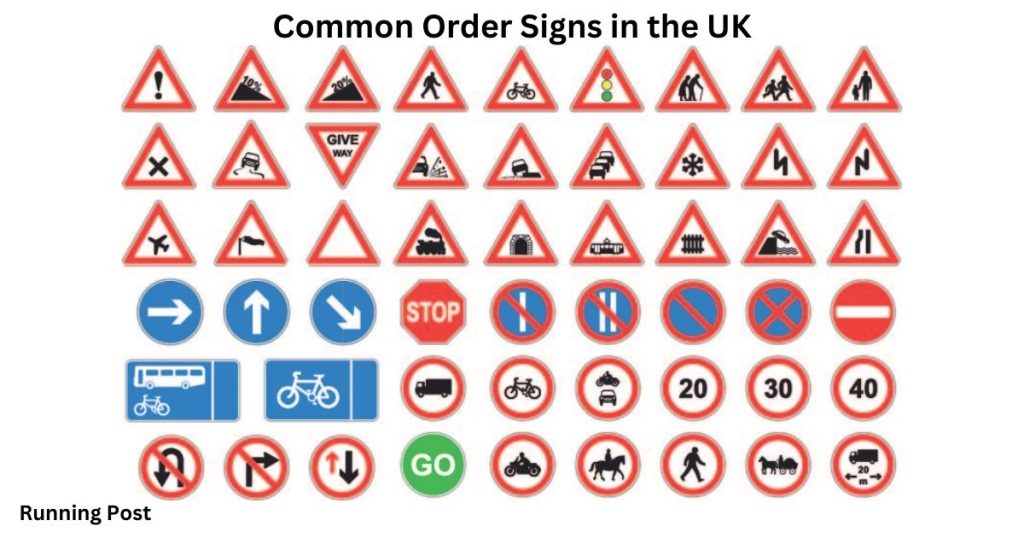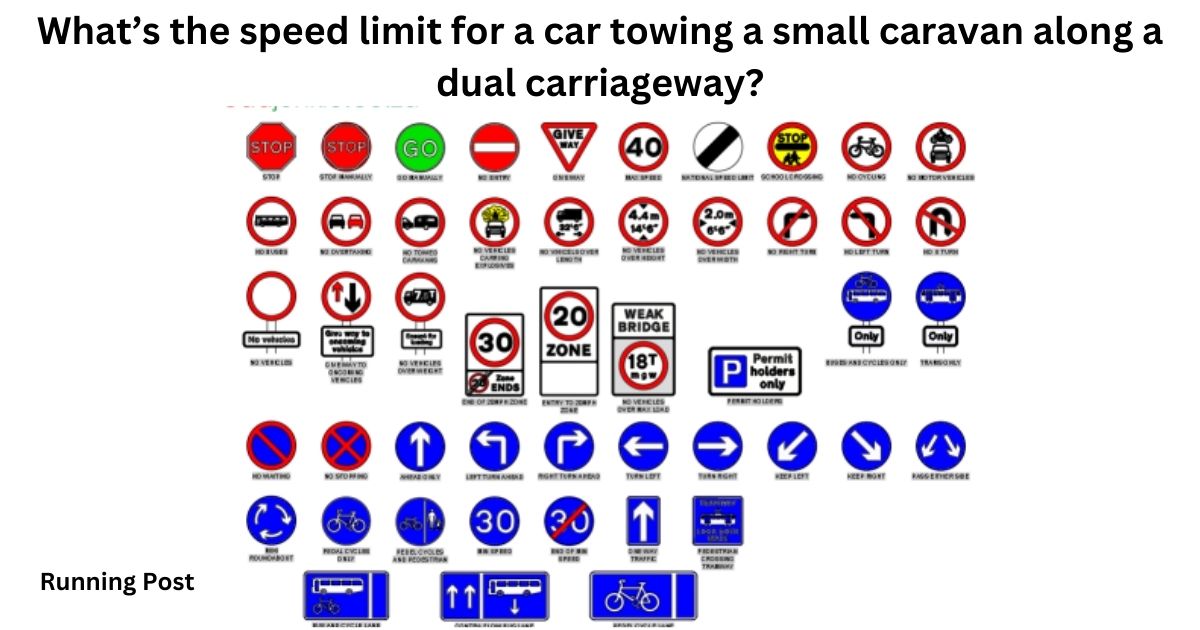| A: Red circles | B: Blue rectangles | C: Red triangles | D: Green rectangles |
How to Identify Traffic Signs That Give Orders
Traffic signs are essential tools for regulating road traffic and ensuring safety. Among the various types of signs, those that give orders play a critical role in directing drivers and pedestrians. These signs are designed to provide clear, imperative instructions that must be followed to maintain orderly and safe traffic flow.
Order signs are usually straightforward, providing specific commands such as “stop,” “give way,” or “turn left.” Understanding how to identify these signs is crucial for adhering to road regulations and avoiding potential hazards. In the UK, traffic signs that give orders are standardized, making it easier for drivers to recognize and respond appropriately. This article will guide you through the characteristics of these signs, their common types, and the proper way to respond when you encounter them.
Understanding Traffic Signs That Give Orders
Definition of Traffic Signs That Give Orders
Traffic signs that give orders are designed to command or direct specific actions from road users. These signs are part of a broader system of road signs that include warnings, information, and guidance. The primary purpose of order signs is to ensure that drivers and pedestrians follow essential rules that facilitate smooth and safe traffic movement.
These signs are legally enforceable, meaning that ignoring them can lead to penalties or accidents. Their design and placement are standardized to make them easily recognizable and understandable. For example, a “stop” sign mandates that drivers come to a complete stop, while a “give way” sign instructs them to yield to other road users.
Overview of Traffic Signs
Traffic signs are categorized into different types, including regulatory signs, warning signs, and informational signs. Each category serves a unique purpose in traffic management. Regulatory signs, which include order signs, are used to enforce rules that must be followed. They often have a circular shape with a red border, indicating their mandatory nature.
Other types of signs, such as warning signs, alert drivers to potential hazards, while informational signs provide guidance or instructions. Understanding the distinction between these types helps drivers interpret signs accurately and respond appropriately.
Purpose of Order Signs
The main purpose of order signs is to regulate traffic and ensure safety. They provide clear directives that drivers and pedestrians must follow to prevent accidents and maintain order on the roads. For example, a “no entry” sign prevents vehicles from entering restricted areas, while a “turn right” sign directs traffic flow in a specific direction.
By enforcing these rules, order signs help manage traffic congestion, prevent collisions, and ensure that road users adhere to established regulations. Their design and placement are carefully considered to maximize visibility and effectiveness.
Key Characteristics of Order Signs in the UK
Understanding the key characteristics of order signs in the UK is essential for recognizing and following them correctly. These signs are designed to provide clear and direct instructions to ensure road safety and smooth traffic flow. Here’s a detailed look at their key features:
Color and Shape of Order Signs
- Red Circles: The Primary Indicator
- Definition: The red circle is the most prominent feature of order signs in the UK. It is used to signal mandatory actions that drivers and pedestrians must follow.
- Design: Typically, these signs have a red border with a white background and black or red symbols or text inside the circle. This design makes them easily identifiable and emphasizes their importance.
- Examples: Common examples include the “Stop” sign, which is a red circle with a white background and the word “STOP” in red text, and the “No Entry” sign, which features a red circle with a white horizontal bar.
- Other Shapes and Colors
- Blue Circles: Although less common for order signs, blue circles are sometimes used to indicate mandatory actions or directions. For instance, a blue circle may be used for signs that instruct drivers to “Turn Left” or “Keep Clear.”
- Rectangular and Square Signs: Some order signs may also be rectangular or square, particularly when additional information or instructions are needed. For example, a rectangular sign might be used to indicate specific turning restrictions or lane instructions.
Red Circles: The Main Indicator
- Purpose and Significance
- Mandatory Action: The red circle is a clear indicator that the sign conveys a mandatory action or prohibition. The use of red ensures that these signs capture attention and are associated with rules that must be followed.
- Visual Impact: The bright red color and distinct circular shape help the sign stand out from other types of traffic signs, making it easier for drivers to recognize and comply with the instruction.
- Usage Examples
- “Stop” Sign: Requires drivers to come to a complete halt at intersections or junctions.
- “No Entry” Sign: Prevents vehicles from entering restricted areas, such as one-way streets or private properties.
Other Shapes and Colors
- Blue Circular Signs
- Purpose: Blue circular signs are used to indicate mandatory actions or directions but are less common for prohibitions. They may instruct drivers to take specific actions, such as “Turn Left” or “Keep Clear.”
- Design: Typically features a blue background with white symbols or text, making it distinct from the red circle used for prohibitions.
- Rectangular Signs
- Purpose: Rectangular signs often provide additional guidance or instructions that complement the primary order signs. They can include information about lane usage, speed limits, or specific turning instructions.
- Design: These signs may have varying color schemes, such as white with black text or colored backgrounds, depending on the specific instruction they are conveying.
Understanding these key characteristics helps drivers quickly identify and respond to order signs, ensuring safe and compliant driving practices on UK roads.
Common Order Signs in the UK

Signs That Indicate You Must Give Way
Several signs in the UK indicate that drivers must give way to other road users. These signs are crucial for managing traffic flow and preventing collisions at intersections and junctions.
The “Give Way” Sign
The “give way” sign is one of the most common order signs. It is typically triangular, with a red border and a white background. This sign instructs drivers to yield to traffic coming from the right or from other directions at intersections. It is important to understand and obey this sign to avoid potential accidents and ensure smooth traffic movement.
Comparison with Other Signs
The “give way” sign is often compared to the “stop” sign, which is another critical order sign. While the “give way” sign requires drivers to yield to other traffic, the “stop” sign mandates a complete halt. Both signs serve to regulate traffic flow but have different requirements for compliance.
Signs for Specific Orders
In addition to the “give way” and “stop” signs, there are various other order signs used in the UK to convey specific instructions. These signs include those indicating “no entry,” “turn left,” and “turn right,” among others.
Examples of Order Signs
Examples of order signs include “no entry,” which prevents vehicles from entering restricted areas, and “turn right,” which directs drivers to make a right turn at an intersection. These signs are designed to provide clear and concise instructions that must be followed to ensure road safety and compliance with traffic regulations.
How to Interpret Them
Interpreting order signs involves understanding their shape, color, and the specific instruction they convey. For example, a red circle with a white background indicates a mandatory action, while a blue circle may provide additional guidance. Familiarizing yourself with these signs helps you respond appropriately and avoid potential issues on the road.
You Also Like It:
What’s a rumble device designed to do?
What makes your tyres illegal?
You’re driving a car fitted with automatic transmission. Why would you use kick-down?
Identifying and Responding to Order Signs
Tips for Recognizing Order Signs on the Road
Recognizing order signs on the road involves paying attention to their distinctive colors and shapes. Red circles are the primary indicator of order signs, while other shapes and colors may provide additional instructions or guidance.
Visual Cues and Placement
Order signs are strategically placed to ensure visibility and effectiveness. They are often located at key points, such as intersections and junctions, where their instructions are most relevant. By observing these signs and understanding their placement, drivers can better anticipate and respond to road conditions.
Differences Between Orders and Warnings
Order signs differ from warning signs in their purpose and design. While order signs provide mandatory instructions that must be followed, warning signs alert drivers to potential hazards or changes in road conditions. Understanding these differences helps drivers interpret signs correctly and respond appropriately.
What to Do When You See an Order Sign
When encountering an order sign, it is important to follow the instruction provided to ensure road safety and compliance with traffic regulations. Ignoring these signs can lead to accidents, fines, or other consequences. Proper reactions include adhering to the instruction, such as stopping at a “stop” sign or yielding at a “give way” sign.
Proper Reactions and Compliance
Proper reactions to order signs involve following the instructions exactly as indicated. This may include coming to a complete stop, yielding to other traffic, or making a specific turn. Ensuring compliance with these signs helps maintain safe and orderly traffic flow.
Consequences of Ignoring Order Signs
Ignoring order signs can result in various consequences, including traffic fines, points on your driving license, or even accidents. Adhering to these signs is essential for ensuring road safety and avoiding legal repercussions.
FAQs About Identifying Traffic Signs That Give Orders
1. What are traffic signs that give orders?
Traffic signs that give orders are regulatory signs designed to direct or command specific actions from drivers and pedestrians. They typically include instructions such as “stop,” “give way,” or “no entry.” These signs are legally enforceable, meaning that road users must comply with the instructions to avoid penalties and ensure safety.
2. How can you identify traffic signs that give orders?
In the UK, traffic signs that give orders are primarily identified by their shape and color. Most of these signs are circular with a red border. The red circle is a key indicator that the sign provides a mandatory instruction. For example, a red circle with a white background signifies that a particular action must be taken, such as stopping or yielding.
3. What color are signs that give orders?
Signs that give orders are often characterized by their use of red. The red circle is the most common color used to indicate mandatory actions. In addition to red, some order signs may use other colors, such as blue, but red remains the primary color associated with regulatory instructions.
You Also Like It:
What should you do before driving into a tunnel?
What Should you do Immediately After Joining a Motorway?
How much more fuel will you use by driving at 70 mph, compared with driving at 50 mph?
4. Which sign gives you the order to give way?
The “give way” sign is a triangular sign with a red border and a white background. It instructs drivers to yield to other road users, typically at intersections or junctions. This sign is crucial for managing traffic flow and preventing collisions by ensuring that vehicles give priority to others when necessary.
5. Which sign is used for orders?
Order signs are used to convey specific instructions or commands to road users. The most common type of order sign is the circular sign with a red border. Examples include the “stop” sign, which requires drivers to come to a complete halt, and the “no entry” sign, which prevents vehicles from entering restricted areas. Each of these signs uses clear, standardized symbols to communicate essential regulations.
6. Are there other shapes and colors used for order signs?
While red circles are the most common shape for order signs, other shapes and colors may be used for specific instructions. For instance, blue circular signs may indicate mandatory actions, such as “turn left” or “keep clear.” Rectangular signs might also be used in conjunction with circular signs to provide additional guidance or information.
7. How should you respond to order signs?
When you encounter an order sign, it is important to follow the instruction exactly as indicated. This means coming to a complete stop at a “stop” sign, yielding to other traffic at a “give way” sign, or adhering to any other specific direction provided by the sign. Properly responding to order signs helps maintain safe and orderly traffic flow.
8. What happens if you ignore order signs?
Ignoring order signs can lead to various consequences, including traffic fines, points on your driving license, or even accidents. Compliance with these signs is essential for ensuring road safety and avoiding legal repercussions. Always pay attention to and follow the instructions provided by order signs to prevent potential issues.
Releated Posts
MAB Instructor Certification: Your Gateway to Professional Crisis Management Leadership
In today’s fast-evolving professional environments—especially in healthcare, mental health, education, and corrections—conflict and aggression can arise without warning.…
Freewayget.com: Your Ultimate Platform for Deals, Discounts, and Digital Products
Introduction to Freewayget.com In today’s fast-paced digital world, finding reliable platforms that offer authentic discounts, deals, and digital…
Affordable & Fast Embroidery Digitizing Services in Your Area
Embroidery digitizing services provide corporations, designers, and people with brilliant embroidery-equipped designs by means of changing art work…
Introduction to hdhub4u nit
In this article, we will delve into the details of hdhub4u nit, exploring its features, benefits, and why…

















